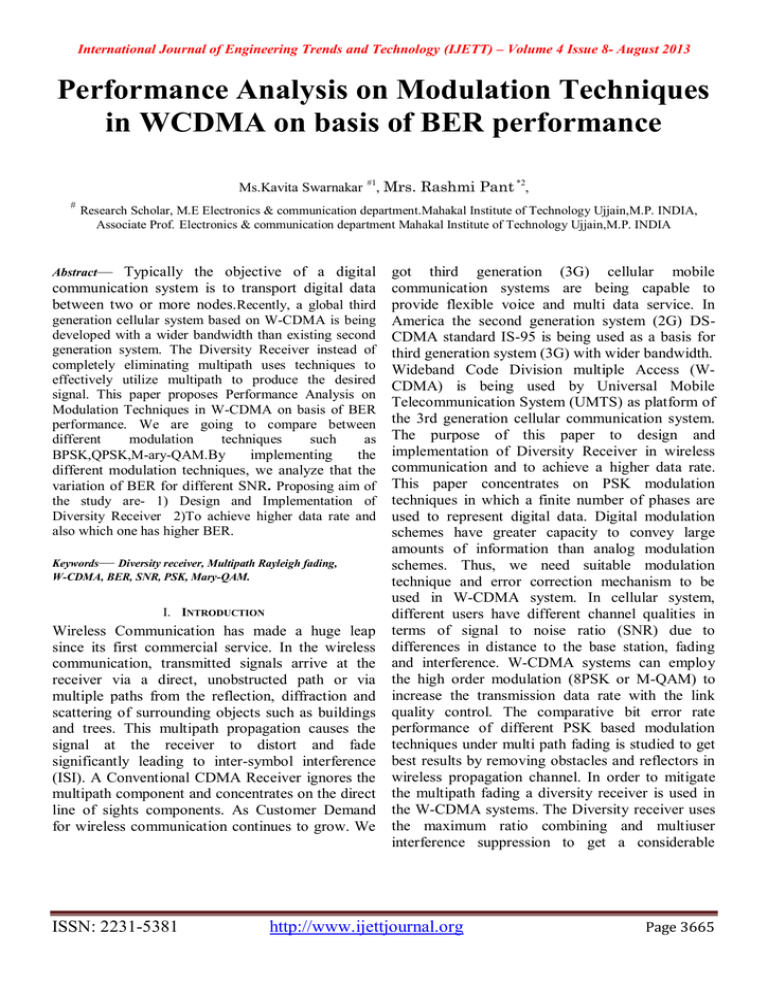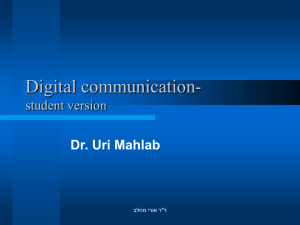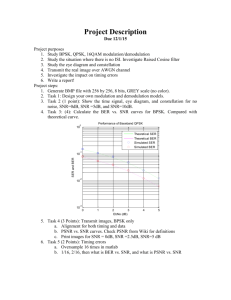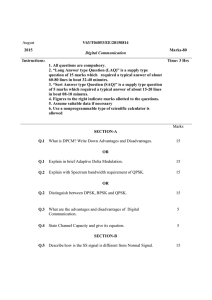Performance Analysis on Modulation Techniques Mrs. Rashmi Pant
advertisement

International Journal of Engineering Trends and Technology (IJETT) – Volume 4 Issue 8- August 2013
Performance Analysis on Modulation Techniques
in WCDMA on basis of BER performance
Ms.Kavita Swarnakar #1, Mrs. Rashmi Pant *2,
#
Research Scholar, M.E Electronics & communication department.Mahakal Institute of Technology Ujjain,M.P. INDIA,
Associate Prof. Electronics & communication department Mahakal Institute of Technology Ujjain,M.P. INDIA
Abstract— Typically the objective of a digital
got third generation (3G) cellular mobile
communication systems are being capable to
provide flexible voice and multi data service. In
generation cellular system based on W-CDMA is being America the second generation system (2G) DSdeveloped with a wider bandwidth than existing second CDMA standard IS-95 is being used as a basis for
generation system. The Diversity Receiver instead of third generation system (3G) with wider bandwidth.
completely eliminating multipath uses techniques to Wideband Code Division multiple Access (Weffectively utilize multipath to produce the desired CDMA) is being used by Universal Mobile
signal. This paper proposes Performance Analysis on
Telecommunication System (UMTS) as platform of
Modulation Techniques in W-CDMA on basis of BER
performance. We are going to compare between the 3rd generation cellular communication system.
different
modulation
techniques
such
as The purpose of this paper to design and
BPSK,QPSK,M-ary-QAM.By
implementing
the implementation of Diversity Receiver in wireless
different modulation techniques, we analyze that the communication and to achieve a higher data rate.
variation of BER for different SNR. Proposing aim of This paper concentrates on PSK modulation
the study are- 1) Design and Implementation of techniques in which a finite number of phases are
Diversity Receiver 2)To achieve higher data rate and used to represent digital data. Digital modulation
also which one has higher BER.
schemes have greater capacity to convey large
amounts of information than analog modulation
Keywords— Diversity receiver, Multipath Rayleigh fading,
schemes. Thus, we need suitable modulation
W-CDMA, BER, SNR, PSK, Mary-QAM.
technique and error correction mechanism to be
used in W-CDMA system. In cellular system,
I. INTRODUCTION
different users have different channel qualities in
Wireless Communication has made a huge leap terms of signal to noise ratio (SNR) due to
since its first commercial service. In the wireless differences in distance to the base station, fading
communication, transmitted signals arrive at the and interference. W-CDMA systems can employ
receiver via a direct, unobstructed path or via the high order modulation (8PSK or M-QAM) to
multiple paths from the reflection, diffraction and increase the transmission data rate with the link
scattering of surrounding objects such as buildings quality control. The comparative bit error rate
and trees. This multipath propagation causes the performance of different PSK based modulation
signal at the receiver to distort and fade techniques under multi path fading is studied to get
significantly leading to inter-symbol interference best results by removing obstacles and reflectors in
(ISI). A Conventional CDMA Receiver ignores the wireless propagation channel. In order to mitigate
multipath component and concentrates on the direct the multipath fading a diversity receiver is used in
line of sights components. As Customer Demand the W-CDMA systems. The Diversity receiver uses
for wireless communication continues to grow. We the maximum ratio combining and multiuser
interference suppression to get a considerable
communication system is to transport digital data
between two or more nodes.Recently, a global third
ISSN: 2231-5381
http://www.ijettjournal.org
Page 3665
International Journal of Engineering Trends and Technology (IJETT) – Volume 4 Issue 8- August 2013
increase in performance and analysis of W-CDMA
system. Multipath fading is one of the major
practical concerns in wireless communications. The
Diversity Receiver has been used to reduce the
multipath fading in W-CDMA system. In order to
mitigate the multipath fading a diversity receiver is
used in the W-CDMA systems in which
considerable gain is achieves by the combination of
multipath signal with the different delays. Finally
we will see that in our proposing work Diversity
Receiver is better performer The performance of
WCDMA system shows that QAM modulation
technique has a higher data rate performance
compared to that of BPSK and QPSK.
II. MODULATION SCHEMES
a) Binary Phase Shift Keying (BPSK)
BPSK is the simplest form of phase shift keying
(PSK). It uses two phases which are separated by
180° and so can also be termed 2-PSK. It does not
particularly matter exactly where the constellation
points are positioned, and in this figure they are
shown on the real axis, at 0° and 180°.This
modulation is the most robust of all the PSKs since
it takes the highest level of noise or distortion to
make the demodulator reach an incorrect decision.
It is, however, only able to modulate at 1 bit/symbol
(as seen in the fig3.1) and so is unsuitable for high
data-rate applications. The general form for BPSK
follows the equation:
Sn(t)=√2Eb/TbCos(2πfct+π(1-n)),n=0,1-(1)
terms of the sine and cosine waves used to transmit
them.
Sqpsk(t) ={√E Cos[(i-1)π/2]∅1(t) - √E Sin[(i-1)∅2(t)} (2)
c)
Quadrature Amplitude Modulation (QAM)
Quadrature amplitude modulation (QAM) is both
an analog and a digital modulation scheme. It
conveys two analog message signals, or two digital
bit streams, by changing (modulating) the
amplitudes of two carrier waves, using the
amplitude-shift keying (ASK) digital modulation
scheme or amplitude modulation (AM) analog
modulation scheme. The two carrier waves, usually
sinusoids, are out of phase with each other by 90°
and are thus called quadrature carriers or quadrature
components The modulated waves are summed, and
the resulting waveform is a combination of both
phase-shift keying (PSK) and amplitude-shift
keying (ASK), or (in the analog case) of phase
modulation (PM) and amplitude modulation.The
general form of an M-ary signal can be defined as:
Sn(t)= √2Emin/Ts ai Cos(2πfct)+ √2Emin/Ts bi sin(2πfct)
0≤t≤T
and
i=1,2,3…M
(3)
where Emin is the energy of the signal with the
lowest amplitude and ai and bi are a pair of
independent integers chosen according to the
location of the particular signal point. Theoretically,
higher order of M-ary QAM enables data to be
transmitted in a much smaller spectrum. However,
the symbols are easily subjected to errors due to
noise and interference because the symbols are
located very closed together in the constellation
diagram.
b) Quadrature Phase Shift Keying (QPSK)
QPSK is one example of M-ary PSK modulation
technique (M = 4) where it transmits 2 bits per
symbol. The phase carrier takes on one of four
equally spaced values, such as 0, π/2, π and 3π/2,
where each value of phase corresponds to a unique
pair of message bits. The implementation of QPSK
is more general than that of BPSK and also
indicates the implementation of higher-order PSK.
Writing the symbols in the constellation diagram in
ISSN: 2231-5381
III.SYSTEM MODEL
In the previous time single user detection methods
have been developed which model interference in a
similar way after that proposed a W-CDMA
receiver. In W-CDMA system many user transmit
information simultaneously. In W-CDMA system
each user has a unique code because of it is known
as code division multiple access techniques. User
sends many information in the form of images, data
http://www.ijettjournal.org
Page 3666
International Journal of Engineering Trends and Technology (IJETT) – Volume 4 Issue 8- August 2013
message, audio, video etc. The communication
system shown as:
Where N0 is a constant and called the noise power
density.
Each user’s data sequence is first modulated using
QPSK modulation. The transmitted signal of user k can
be expressed as,
xk(t) =
(i)
,i(t-IT)
(5)
Where Ek is the average symbol energy and T is
symbol duration.
In simulating multipath fading environment, only the
relative signal level and relative delay time of the
delayed waves need to be given in comparison with the
direct wave.
Fig -system model
The spreading waveform for the kth user,
In DS-Spread Spectrum, each user is assigned a
unique Walsh code and transmitted data is
multiplied by its corresponding spreading code.
Modulated data through the spread code occupies
more bandwidth than transmitted data.One of the
most important limitations in the field of digital
communications is channel capacity. Cause of this,
many methods has been designed to goal the usage
of a channel in the most efficient way. For cellular
mobile communications the most relevant method
is multiple accesses techniques. This method allows
us to transmit and receive information from
different sources through the same channel. So,
many users can communicate using the same
channel. Some of the multiple access methods are
Time-Division
Multiple
Access
(TDMA),
Frequency-Division Multiple Access (FDMA), and
Code-Division Multiple Access (CDMA). There are
two types of CDMA. The first is Frequency-Hopping
(FH-CDMA), and the second is direct sequence (DSCDMA). Each user’s data sequence is first modulated
using QPSK modulation which is then used to spread the
QPSK-modulated signal using direct sequence CDMA
(DS-CDMA).The channel is assumed to corrupt the
signal by the addition of white Gaussian noise as
therefore the transmitted signal, white Gaussian noise
and received signal are expressed by the following
equation with s(t),n(t) and r(t) representing those signals
respectively[8]:
Ωnm f = ½ N0 [W/HZ]
ISSN: 2231-5381
(4)
ak, i(t) =
(j) p(t-jTC)
(6)
The received signal can be obtained as,
r(t)
(t-
)+
(t-Tl)+ n(t)
(7))
After mapping the sequence code takes the form
c(t)
p(t-kTC ),
0
NTc
(8)
With ck = +1,-1 and p(t) is a rectangular pulse of
duration Tc and unit amplitude
IV. PROPOSED W-CDMA SYSTEM MODEL
A Diversity receiver to resolve multipath component
signals that have different path delays. Each multipath
has a different distortion, diffraction, scattering,
reflection etc that is mainly caused by the Rayleigh
fading, AWGN, and the frequency offset between the
source and the destination site. Therefore, the received
signal should undergo phase alignment and frequency
offset alignment specific to the multipath as well as the
despreading process. A power channel estimator
measures the signal power of the multipath to determine
if it is strong enough to be considerable. The deskewer
compensates individual multipath delays. After these
processes the multipath path signals are combined to
recover the desired data .Let hp(t) be the (physical)
multipath channel impulse response. Channel models
http://www.ijettjournal.org
Page 3667
International Journal of Engineering Trends and Technology (IJETT) – Volume 4 Issue 8- August 2013
proposed by IEEE 802.15.3a Task Group [28, 52] are
based on the famous multipath Saleh-Valenzuela model
[58], in which the multipath components arrive at the
receiver in clusters,
x i, n
h(t)
g(t-
)
(11)
x i, n
(12)
(9)
(13)
Transmitter model
h(t)
g(t-
)
(14)
(t)
(15)
The Diversity receiver is a matched filter (the received
pulse is matched with a template that has the same
waveform) and therefore (with known channel
coefficients) optimum with respect to the BER
performance, and it also benefits from the fact that many
results in existing literature on Diversity receivers for
wireless communication systems e.g. WCDMA can still
apply. However, there are some serious practical issues
in this kind of receiver.
Receiver model
V. WALSH HADAMARD SEQUENCE
Basically for spreading data we used different types of
sequence so we have P-N sequence and Walsh –
Hadmard sequence but in this paper for spreading data
and also for better orthogonally we used WalshHadamard sequence so that sequence also called
orthogonal code. For improving better efficiency we
used orthogonal function or Walsh-Hadmard Orthogonal
sequence. For generating Walsh-Hadmard sequence we
have NxN square matrix. To get the desired length of
Hadamard matrix can be generated by the following
manner-
The most well-known approach to deal with multipath
wireless channels is to use diversity receivers, as
implemented successfully in the ―traditional‖ wideband
CDMA systems transmitted over a multipath channel
then the received signal is,
r(t)
h(t-ItF) + n(t)
(10)
Where n(t) is additive noise , h(t) is the composite
channel response h(t)= hp(t)*g(t).
ISSN: 2231-5381
Spreading sequence used for DS-CDMA system can be
represented by JxK matrices BJK. Where J is the number
of sequence and K is sequence code length. The code
sequence is known as orthogonal Sequence if, and only
if matrix BJK is orthogonal –
BJK BJKT = k IM
http://www.ijettjournal.org
(16)
Page 3668
International Journal of Engineering Trends and Technology (IJETT) – Volume 4 Issue 8- August 2013
Where k is the constant and BJKT is transposition of
matrix BJK of order N and IN is the NxN unity matrix. In
the DS-CDMA system the number of chips per data
symbol is known as spreading factor (SF).
VI. MAXIMUM RATIO COMBINING (MRC)
In the field of wireless communication we have much
option to mitigate interference such as ISI, Equalizers
and diversity. Diversity is techniques that will reduce
amplitude fluctuation or fading mitigation. We have
many type of diversity such as Antenna diversity,
feedback diversity, Scanning diversity, Maximum ratio
combining, Equal gain combining, etc. MRC is the
optimist form of diversity combining cause of Maximum
ratio combining all the integration result of code
sequence by this we achieve better bit error ratio (BER)
and maximum signal to noise ratio (SNR).
In Maximum ratio combining all integrated multipath
components such as x1(t), x2(t), x3(t),………. xn(t) So
whole of components are multiplied with complex
conjugate weighted β1*(t),β2*(t), β3*(t)…… βn*(t) of
channel characteristics. Then mathematical expression
of the MRC can be written asx/=
(17)
for the decision bit device after all data is decoded and
probability of error is computed and simulation have run
with the Walsh-Hadamard sequence. Implementing the
different modulation techniques, the criterion is
comparison of the variation of BER for different SNR. It
is observed that the BER is minimum for AWGN and
maximum for Rayleigh and Rician. The performance of
WCDMA system in AWGN channel shows that QAM
modulation technique has a better performance
compared to that of BPSK and QPSK.It also shows that
QA
M
Bit Error Rate1 Bit Error Rate2 Bit Error Rate3
techn for BPSK/QPSK
for 32 QAM
for 64 QAM
ique
SNR
BER
SNR
BER
SNR
BER
is
0.1382
0.151
0.1714
0
0
0
bette
r as 2
0.0996
0.112
0.1474
2
2
comp
0.0382
0.0502
0.093
4
4
4
ared
0.0172
0.0216
0.0538
6
6
6
to
BPS
0.0034
0.0064
0.0184
8
8
8
K
0.0001
0.0003
0.0045
10
10
10
and
QPSK. Also, BPSK and QPSK suffers signal
degradation and error probed when the simulations are
done in these channels.
VII. PERFOMANCE ANALYSIS
The standard Gaussian approximation regarding fading
is used with a signal to noise ratio analysis to derive the
Bit error ratio for QPSK modulation and we have
specific weighted vector ω then the signal to noise ratio
at the output of the maximum ratio combiner can be
easily shown as:
SNR = ωK ggk ω / ωK kω
(18)
Power spectral density of total noise after that Bit Error
Ratio can be written as,
Pe(d) =½erfc(rootof(β SNR(C))
(19)
VIII. RESULT AND DISCUSSION
Table SNR Vs BER for BPSK/QPSK, 32QAM, 64 QAM
QPSK modulation is a technique that will modulate the
transmitted signal and used for the simulations or spread
with the spreading code sequence. Channel noise is
generated and added to the multipath components.
Integration process can take place after the multipath
components is detected after that Maximum ratio
combining can be used for storing the integration results
here combining result of multipath components to send
ISSN: 2231-5381
http://www.ijettjournal.org
Page 3669
International Journal of Engineering Trends and Technology (IJETT) – Volume 4 Issue 8- August 2013
0.2682
0.2832
4
0.2318
0.2574
6
0.1876
0.215
8
0.159
0.1968
10
0.1292
0.1726
12
0.1144
0.168
14
0.0978
0.1522
16
0.0886
0.1402
18
0.0814
0.1388
20
0.0766
0.1318
2
Table SNR Vs BER
BPSK / QPSK ,256 QAM
Fig SNR Vs BER for BPSK/QPSK, 32QAM, 64 QAM
Fig SNR Vs BER
Fig SNR Vs BER
BER
BPSK / QPSK, 256 QAM
BPSK/QPSK
SNR
0
16 QAM, 32 QAM, 64 QAM
BER 256 QAM
0.2968
ISSN: 2231-5381
0.3066
http://www.ijettjournal.org
Page 3670
International Journal of Engineering Trends and Technology (IJETT) – Volume 4 Issue 8- August 2013
Table SNR Vs BER 16 QAM,32 QAM, 64 QAM
VI. CONCLUSION
Performance Analysis on Modulation Techniques in WCDMA on basis of BER performance as the spreading
code has been introduced. We found that diversity
receiver gives the better performance in respect of
system efficiency, SNR and BER performance.QPSK &
BPSK modulation technique performs poorly in WCDMA system.Thus, it is suggested that high data rate
modulation technique such as BPSK and QPSK needs an
error correction coding so that the interference from the
adjacent carrier phase in the constellation of BPSK and
QPSK can be eliminated if not minimized. It is seen that
higher-order modulations exhibit higher error-rates; in
exchange however they deliver a higher raw data-rate
for higher values of Eb / N0, the BER is decreasing in
all the fading channels for different modulation schemes.
The objective of this paper is to review the key
characteristics and salient features of the main digital
modulation schemes used, including consideration of the
receiver and transmitter requirements. So we have seen
that deliver higher data rate with higher modulation and
also seen that higher BER with lower modulation
techniques.
REFERENCE
[1] O.Fonseca and I.N.Psaromiligkos, Electronics Letters, Sep. 2006,
42, 20.
[2] U.H. Rizvi,G.J.M. Janseen and J.H.Webber. BER analysis of
BPSK and QPSK constellations in the presence of ADC quantization
noise. Proceeding of APCC 2008, 2008.
[3] K.Murota,K.Hirade. IEEE Trans. Comm.,july, 1981, 29, 10441050.
[4] M.K. Simon, M.S. Alouini. Digital Communication over Fading
Channels: A Unified
Approach to Performance Analysis Copyright. 2000, John Wiley &
Sons, Inc.
.
[5] Proakis, J.G. Digital Communications, 3rd ed., NY: Mcgraw-Hill,
1995.
ISSN: 2231-5381
16- QAM
32 QAM
64 QAM
SNR
BER
SNR
BER
SNR
BER
0
0.3078
0
0.3078
0
0.3378
2
0.2554
2
0.02654
2
0.3018
4
0.2226
4
0.2226
4
0.2644
6
0.173
6
0.1864
6
0.2293
8
0.1422
8
0.1614
8
0.1938
10
0.1088
10
0.1358
10
0.169
12
0.0828
12
0.1112
12
0.1531
14
0.0694
14
0.096
14
0.1357
16
0.0628
16
0.095
16
0.1337
18
0.0554
18
0.084
18
0.1167
20
0.0472
20
0.0762
20
0.1121
[6] Hiroshima Harada, Ramjee Prasad, Simulation & Software Radio
for Mobile
communication, 71-164, 2002.
[7] Lawrence Harte, Richard Levine, Roman Kikta, 3G Wireless
Demystified: Mcgraw-Hill,
2002.
[8] Dr Pao Lo Lui, Comparison of Single Carrier and Multi-carrier
(OFDM) PSK transmission
schemes in Multi-path Wireless channel.
[9] Sampei, S., Applications of Digital Wireless Technologies to
Global Wireless Communications, Upper Saddle River, NJ: Prentice
Hall, 1997.
[10] Prasad, J. G., Digital Communications, 3rd Edition., New York:
McGraw Hill, 1995
[11] Jakes, W.C., Microwave Mobile Communications,
NewYork:IEEE Press.
[12] Iraji, S. and Lilleberg, J. ―EM-based multiuser detection and
parallel interference cancellation for space-time block coded
WCDMA systems employing 16-QAM over multipath fading
channels IEEE conference on Personal, Indoor and Mobile Radio
Communications, vol.2, pp.688-692, 2002.
[13] Min-yan Song, Yang Xiao and Habermann, J. ―High data rate
wireless system, IEEE conference on Signal Processing, vol.2,
pp.1344-1350, 2002.
http://www.ijettjournal.org
Page 3671
International Journal of Engineering Trends and Technology (IJETT) – Volume 4 Issue 8- August 2013
[14] Rosmansyah Y, Sweeney P and Tafazolli, R, ―Air-interface
techniques for achieving high data rates for UMTS, IEEE conference
on 3G Mobile Communication Technologies, pp.368-372, 2001.
[15] Mohr, W. and Becher, R, ―Mobile communications beyond third
generation‖, IEEE conference on Vehicular Technology Conference,
vol.2, pp.654-661,
ISSN: 2231-5381
http://www.ijettjournal.org
Page 3672


